Research Activities > Programs >
Sparse Representation in Redundant Systems
>
Naoki Saito
|
|

CSIC Building (#406),
Seminar Room 4122.
Directions: home.cscamm.umd.edu/directions
|

Data Analysis and Representation on General Domains with Eigenfunctions of Laplacian
Dr. Naoki Saito
Mathematics at University of California at Davis
|
|
Abstract:
I plan to discuss a new method to analyze and represent data recorded on a domain of general shape or more generally over a set in the Euclidean space by computing the eigenfunctions of Laplacian defined over there, and expanding the data or function on the domain into these eigenfunctions. Such a method may be useful for analyzing the data sampled on a group of sensors in meteorology and geophysics or characterizing specific geometric objects in an image such as human eyes or some biological cells/tissues. Instead of directly solving the eigenvalue problems associated with the Laplacian on such a domain (which can be quite complicated and costly), I diagonalize the integral operator commuting with the Laplacian. It turns out that this integral operator is a specific realization of the more general "geometric harmonics" recently proposed by Coifman and Lafon. These eigenfunctions are also "modes" of the vibration of the domain if the domain is interpreted as a "drum". This representation system can be redundant if the original domain is split into a set of mutually exclusive subdomains and the Laplacian eigenfunctions are computed on each such subdomain. I will demonstrate that my approach generate a sparse representation of data defined on an irregular domain. I will also show that my method is better suited for small sample data than the Karhunen-Loeve transform using some interesting examples. I also hope to discuss possible approaches to reduce the computational burden of the eigenfunction computation including:
1) sparsifying the kernel of the integral operator via Alpert's wavelets; or
2) combining fast multipole method (FMM) and Krylov subspace method.
|
|
|
